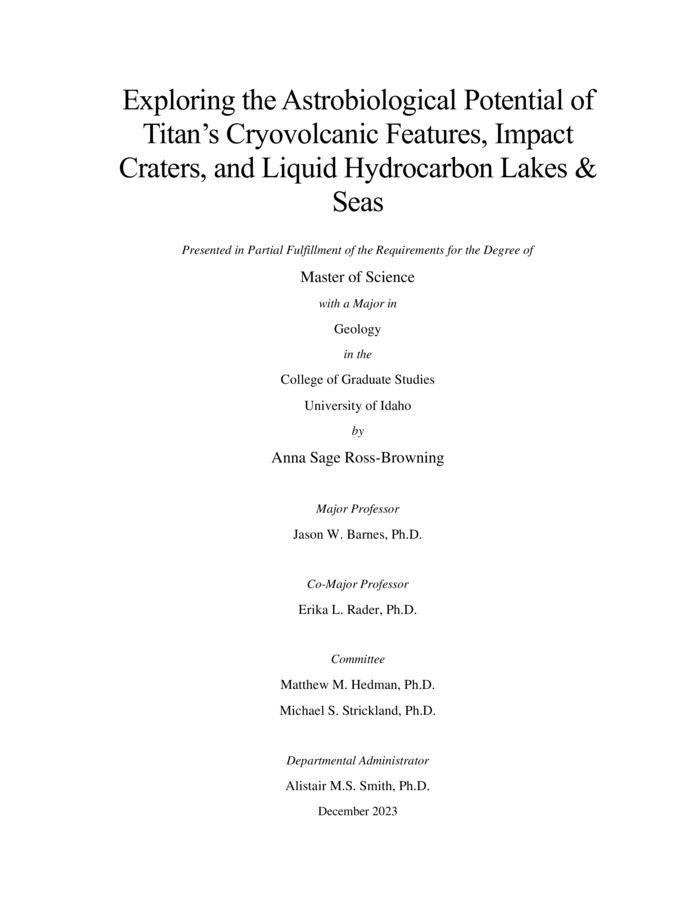Exploring the Astrobiological Potential of Titan's Cryovolcanic Features, Impact Craters, and Liquid Hydrocarbon Lakes \& Seas
Ross-Browning, Anna Sage. (2023-12). Exploring the Astrobiological Potential of Titan's Cryovolcanic Features, Impact Craters, and Liquid Hydrocarbon Lakes \& Seas. Theses and Dissertations Collection, University of Idaho Library Digital Collections. https://www.lib.uidaho.edu/digital/etd/items/rossbrowning_idaho_0089n_12750.html
- Title:
- Exploring the Astrobiological Potential of Titan's Cryovolcanic Features, Impact Craters, and Liquid Hydrocarbon Lakes \& Seas
- Author:
- Ross-Browning, Anna Sage
- ORCID:
- 0000-0002-2194-4268
- Date:
- 2023-12
- Keywords:
- Astrobiology Impact craters Light attenuation Liquid hydrocarbon lakes and seas Photosynthesis Titan
- Program:
- Earth and Spatial Sciences
- Subject Category:
- Geology; Astronomy; Physics
- Abstract:
-
Saturn's moon Titan has garnered significant astrobiological attention due to its Earth-like characteristics, which include its thick atmosphere, meteorological cycle, and long-lasting liquid bodies on its surface. The upcoming Dragonfly mission -- scheduled to launch in the 2020s -- aims to explore the surface of Titan and to search for past and present signs of habitability. However, Titan's extremely cold average surface temperature of 94 K poses challenges for the existence of liquid water on its surface but for two geologic and astronomical processes -- cryovolcanism and impact events. This thesis investigates the features created by these processes -- as well as the liquid methane and ethane lakes and seas -- and their potential roles in supporting prebiotic or biotic chemistry. Chapter 1 introduces the significance of this work and outlines its structure. In Chapter 2, I analyze the astrobiological potential of cryovolcanic features and impact craters by performing a literature review. In Chapter 3, I use the Beer-Lambert-Bouguer law to examine how light incident on Titan's surface attenuates in impact melt crater pools and the hydrocarbon lakes and seas to determine if photosynthetically available radiation (PAR) could be suitable as a primary or secondary energy source for putative life. Chapter 4 discuss the caveats to this work as well as directions for future research. This work serves as an important discussion about how astrobiological theory may be applied to Titanian environments to assess what habitability- and bio-signatures could be created by prebiotic or biotic chemistry in Titan's unique environments. This thesis will contribute to understanding potential habitability and potential biosignatures in Titan's environments, informing future missions to Titan and other icy moons.
- Description:
- masters, M.S., Earth and Spatial Sciences -- University of Idaho - College of Graduate Studies, 2023-12
- Major Professor:
- Rader, Erika L; Barnes, Jason W
- Committee:
- Strickland, Michael S; Hedman, Matthew M; Smith, Alistair
- Defense Date:
- 2023-12
- Identifier:
- RossBrowning_idaho_0089N_12750
- Type:
- Text
- Format Original:
- Format:
- application/pdf
- Rights:
- In Copyright - Educational Use Permitted. For more information, please contact University of Idaho Library Special Collections and Archives Department at libspec@uidaho.edu.
- Standardized Rights:
- http://rightsstatements.org/vocab/InC-EDU/1.0/

